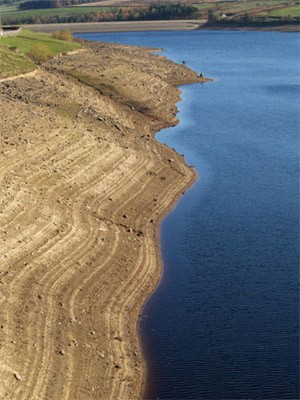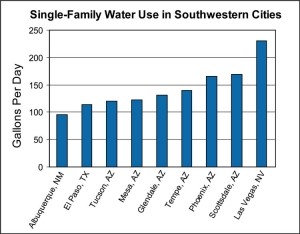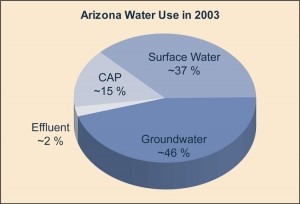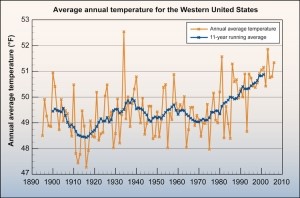Water Supply
Lake Powell was nearly full in the fall of 1999. A mere five years later, that high water mark painted white on the red rocks was about 140 feet lower. For five consecutive years, drought in the Upper Colorado River Basin limited the water flow into Lake Powell to no more than 62 percent of the historical average. In 2004, the mammoth reservoir was only one-third full. This precipitous decline in water storage highlighted the vulnerability of the resource to the confluence of climate and societal demand.

Perhaps no other natural resource is as important to people in the Southwest as water. To support municipal demand and agriculture, water is mined from the ground, diverted from rivers, and stored in reservoirs. Recent drought conditions, the severity of past droughts, and projected population growth are forcing water managers to rethink management strategies. In fact, in December 2007 the Bureau of Reclamation began using new operational guidelines for the Colorado River that include preparing for droughts, stimulating water conservation, and modifying the guidelines if future conditions, such as climate changes, require new constraints. The impacts of changes in climate and population will challenge water managers and users in both Arizona and New Mexico. It will become vital to understand:
- Water use in the Southwest
- Climate change impacts on surface water
- Impacts of climate and society changes on groundwater resources
Water use in the Southwest
Groundwater and surface water account for nearly all the water used in the Southwest; reclaimed water, although becoming an important supplement for other sources, provides only a small fraction.
For example, water diverted from streams and rivers in Arizona for 2006 accounted for approximately 55 percent of the total water used; water pumped from wells made up about 45 percent1 (Figure 1).
The Central Arizona Project (CAP) diverts Colorado River water to areas in Arizona. In 2003, CAP channeled 3.7 billion gallons of water (1.15 million acre-feet) to users—an amount equivalent to about 15 percent of Arizona’s total water use.
Both groundwater and surface water supply residential water. In the larger cities in the Southwest, the volume used by single family homes ranges from less than 100 gallons per day to nearly 250 gallons (Figure 2). Agriculture, and not
residential water use, is the biggest drain on groundwater. In 2000, about 80 percent of total groundwater withdrawn in Arizona and parts of other western states, including New Mexico, was used for irrigation.

Climate change impacts on snowpack and streamflows
The average temperature in the West has increased since about 1900, particularly in the last 30 years (Figure 3). As a consequence, in many western mountain ranges less precipitation is falling as snow, and spring melting is occurring earlier in the year. The Colorado River, Rio Grande, and several other southwestern rivers have streamflows that appear to be peaking earlier in the year3, suggesting that the spring temperatures in these regions are warmer than in the past, causing snow to melt earlier.
Warming in the Southwest is expected to continue, most likely intensifying observed changes to the snowpack. As a result of earlier elevated streamflows, there may be a mismatch between peak inflow to and peak outflow from reservoirs, causing water storage to decline at more rapid rates. For example, historically snowmelt occurs as water demand by people ramps up. As a result, reservoirs are better able to maintain constant or positive storage volumes for that year. But when streamflows are elevated earlier in the year, water demand occurs when inflows are less, and water storage declines at a more rapid rate.
In addition, higher temperatures increase evaporative losses in reservoirs and streamflows. Higher temperatures, in combination with growing seasons lengthened by higher spring and fall temperatures, will increase water consumption for domestic use, irrigation, and energy production. Finally, increases in the frequency and extent of droughts will also reduce surface water availability, much like the recent drought.
Impacts of climate and society changes on groundwater resources
Future climate scenarios for the Southwest include warmer temperatures, a larger population, and perhaps less rain. Some estimates based on global climate models (GCMs) suggest that the West will likely warm between 3.5 and 9 degrees F (2 to 5 degrees C) over the next century,4 while an additional 4.8 million people will inhabit Arizona and New Mexico by 2030. And although GCMs do not present a clear image of future precipitation, some models suggest a 10 to 15 percent decrease.5 The confluence of these changes will impact snowpack, evaporation, energy consumption, pumping, and winter storms, all of which impact groundwater supplies.
Air temperatures in the Southwest have increased in the past century, particularly in the last 30 years (see Figure 3), and reductions in snowpack have been linked to this warming. Future climate change will likely continue to diminish snowpack at higher elevations and therefore reduce groundwater recharge2. Temperature increases will also hasten the evaporation of soil moisture after rain and snow storms, reducing the amount of water that seeps into aquifers.
Warmer temperatures may also bump up water consumption in the winter, and therefore groundwater withdrawals, as higher temperatures often correlate with increased water use. Higher summer temperatures also increase energy consumption as people run air conditioners to keep homes and buildings at comfortable temperatures. Because about 8.0 gallons of water are needed to generate one kilowatt of energy in Arizona6, greater energy consumption demands more water, a fraction of which will be from groundwater.
Scenarios that depict decreases in winter precipitation are significant because winter precipitation is considered to be more important in replenishing groundwater than summer rain. Declines in winter precipitation have already been observed and linked to human-caused climate change. Research in 2008 concluded the winter storm tracks in the western U.S. shifted north between 1978 and 1998, delivering fewer rain and snow events to Arizona and western New Mexico, among other western states7.
Increases in temperature and population are almost certainly going to occur in future. Together, these events will stress both groundwater and surface water supplies in ways that will require innovative and well-planned water management strategies. And although decreases in precipitation are less certain, they may also exacerbate the climate change impacts on water supplies.
References
- Arizona Department of Water Resources. 2006. Arizona Water Atlas. Volume 1: Introduction. http://www.azwater.gov/dwr/Content/Find_by_Program/Rural_Programs/conten... (Last accessed on April 22, 2009).
- Stonestrom, D.A. and J.R. Harrill. 2007. Ground-water recharge in the arid and semiarid southwestern United States-climatic and geologic framework. U.S. Geological Survey Professional Paper, 1703-A: 27.
- Stewart, I.T., D.R. Cayan and M. D. Dettinger. 2005. Changes toward earlier streamflow timing across western North America. Journal of Climate, 18(8):1136–1155.
- Cubasch, U., et al. 2001. Projections of future climate change. In Climate change 2001: The Scientific Basis. Contribution of Working Group I to the Third Assessment Report of the Intergovernmental Panel on Climate Change, pp. 525-582. Cambridge University Press, Cambridge, UK, 525–582.]
- IPCC. 2007. Climate Change 2007: The Physical Science Basis. Contribution of Working Group 1 to the Fourth Assessment Report of the Intergovernmental Panel on Climate Change.[Solomon, S., D. Qin, M. Manning, Z. Chen, M. Marquis, K.B. Averyt, M. Tignor and H.L. Miller (eds.)]. Cambridge University Press, Cambridge, UK and New York, NY, USA.
- Torcellini, P., N. Long and R. Judkoff. 2003. Consumptive water use for U.S. power production. Technical Report NREL/TP-550-33905. US Department of Energy, National Renewable Energy Laboratory, Golden, Colorado.
- McAfee, S.A. and J.L. Russell. 2008. Northern Annular Mode impact on spring climate in the Western United States, Geophysical Research Letters, 35: L17701, doi: 10.1029/2008GL034828.
Figures
Figure 1. Source of water supplies utilized in 2003 in Arizona.
| Enlarge This Figure |
Credit: 2003 ADWR Arizona Water Atlas
Figure 2. Single-family water use in southwestern cities. Single-family water usage is a useful metric for evaluating how efficiently a community uses water.
| Enlarge This Figure |
Credit: Zack Guido, CLIMAS, The University of Arizona
Figure 3. Average Temperature for 11 western states including Washington, Oregon, California, Nevada, Idaho, Utah, Arizona, Montana, Wyoming, Colorado, and New Mexico. Data were obtained from the National Climatic Data Center, the Center for Climate Prediction, and the National Oceanic Atmospheric Administration cooperative network.
| Enlarge This Figure |
Credit: Zack Guido, CLIMAS, The University of Arizona



